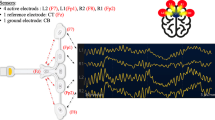Abstract
Differential diagnosis of syncope and seizures frequently imposes a major problem, particularly if interictal examinations are normal. We performed orthostatic testing combined with surface electroencephalography (EEG) and non-invasive measurements of cerebral blood flow velocity. Ten healthy controls, ten patients with confirmed diagnosis of epilepsy and 25 patients with history of syncope of unknown origin were examined. The following parameters were evaluated continuously and simultaneously during orthostatic challenge: computerized EEG with synchronous video-monitoring, transcranial Doppler sonography (TCD), heart rate and blood pressure. Isolated cerebrovascular dysregulation (i.e. a drop in cerebral perfusion despite the absence of a significant drop in peripheral blood pressure) occurred in 2/10 controls, 3/10 patients with epilepsy and 11/25 patients with syncope of unknown origin. The combined EEG and TCD measurements represent a new approach to the work-up of patients with otherwise unexplained syncope, helping us to understand the interdependence of neuronal activity and peripheral/cerebrovascular autoregulation under postural stress.
Similar content being viewed by others
References
Gastaut H. Syncope and seizure. Editorial note.EEG Clin Neurophysiol 1958;15:571–572.
Gastaut H. Syncopes: generalized anoxic cerebral seizures. In: Magnus O, Loretz de Haas, eds.The Epilepsies. New York: American Elsevier, 1974; 815–835.
Ries S, Daffertshofer M, Hennerici M. Multimodal transcranial monitoring for the evaluation of cerebrovascular auto-dysregulation.Cerebrovasc Dis 1996;6 (suppl. 2):1–31.
Natale A, Akhtar M, Jazayeri M et al. Provocation of hypotension during head-up tilt testing in subjects with no history of syncope or presyncope.Circulation 1995;92(1):54–58.
Neuerburg0Heusler D, Hennerici M.Gefäßldiagnostik mit Ultraschall. 2nd edn. Stuttgart: Thieme, 1995.
Lindegaard KF, Lundar T, Wiberg J, Sjoberg D, Aaslid U, Nornes H. Variations in middle cerebral artery blood flow investigated with noninvasive transcranial blood velocity measurements.Stroke 1987;18:1025–1030.
Huber P, Handa J. Effect of contrast material, hypercapnia, hyperventilation, hypertonic glucose and papaverine on the diameter of the cerebral angiographic determination in man.Invest Radiol 1967;2:17–32.
Daffertshofer M, Hennerici M. Cerebrovascular regulation and vasoneural coupling.J Clin Ultrasound 1995;23:125–138.
Petersen ME, Williams TR, Sutton R. Psychogenic syncope diagnosed by prolonged head-up tilt testing.Quart J Med 1995;88(3):209–213.
Mathias CJ. Orthostatic hypotension. Causes mechanisms and influencing factors.Neurology Suppl 1995;45(suppl. 5):6–11.
Grubb BP, Gerard G, Roush K et al. Cerebral vasoconstriction during head-upright tilt-induced vasovagal syncope. A paradoxic and unexpected response.Circulation 1991;84:1157–1164.
Kaufman H, Oribe E. Plasma endothelin during upright tilt: relevance for orthostatic hypotension.Lancet 1991;338:1542–1545.
Diehl B, Diehl RR, Young C, Stodieck SRG. Zerebrale perfusion wahrend photoparoxysmaler EEG-reaktion.Epilepsie Blditter 1996;9(suppl.):8–9.
Grubb BP, Gerard G, Roush K et al. Differentiation of convulsive syncope and epilepsy with head-up tilt testing.Ann Intern Med 1991;11:871–876.
Author information
Authors and Affiliations
Corresponding author
Rights and permissions
About this article
Cite this article
Ladwig, S., Ries, S., Henning, O. et al. Combined electroencephalography and measurements of transcranial blood flow velocity during orthostatic testing—a new approach to assess syncope of unknown origin?. Clinical Autonomic Research 7, 305–309 (1997). https://doi.org/10.1007/BF02267722
Received:
Accepted:
Issue Date:
DOI: https://doi.org/10.1007/BF02267722




